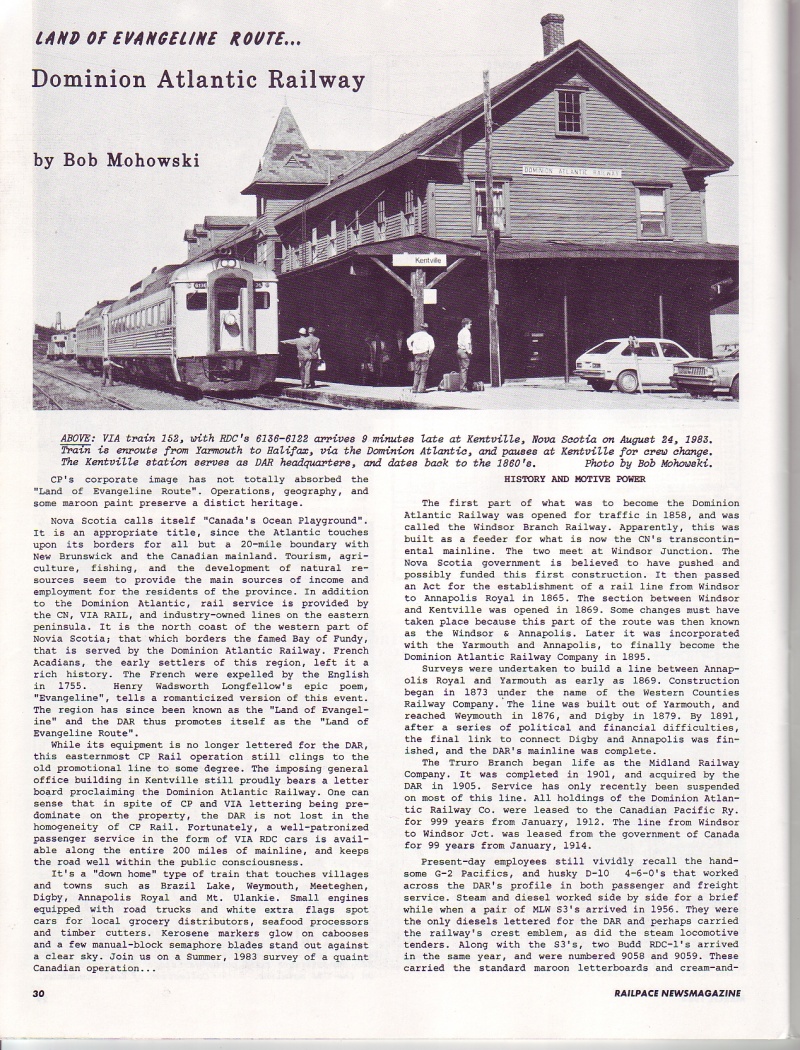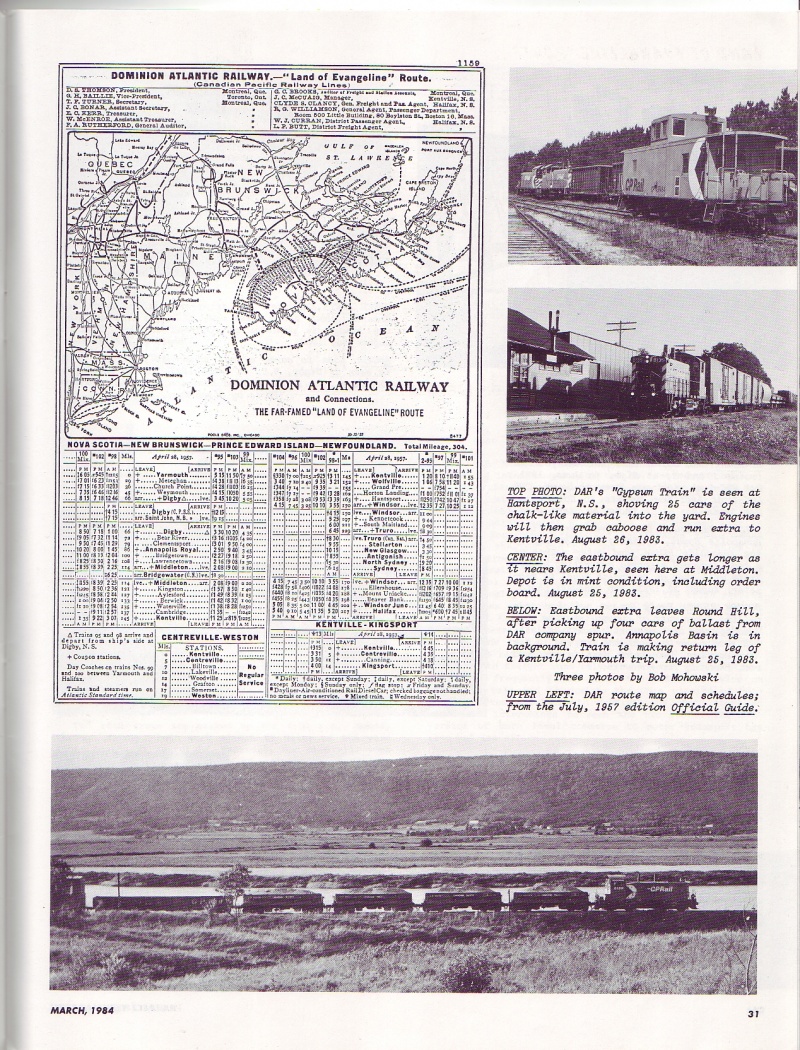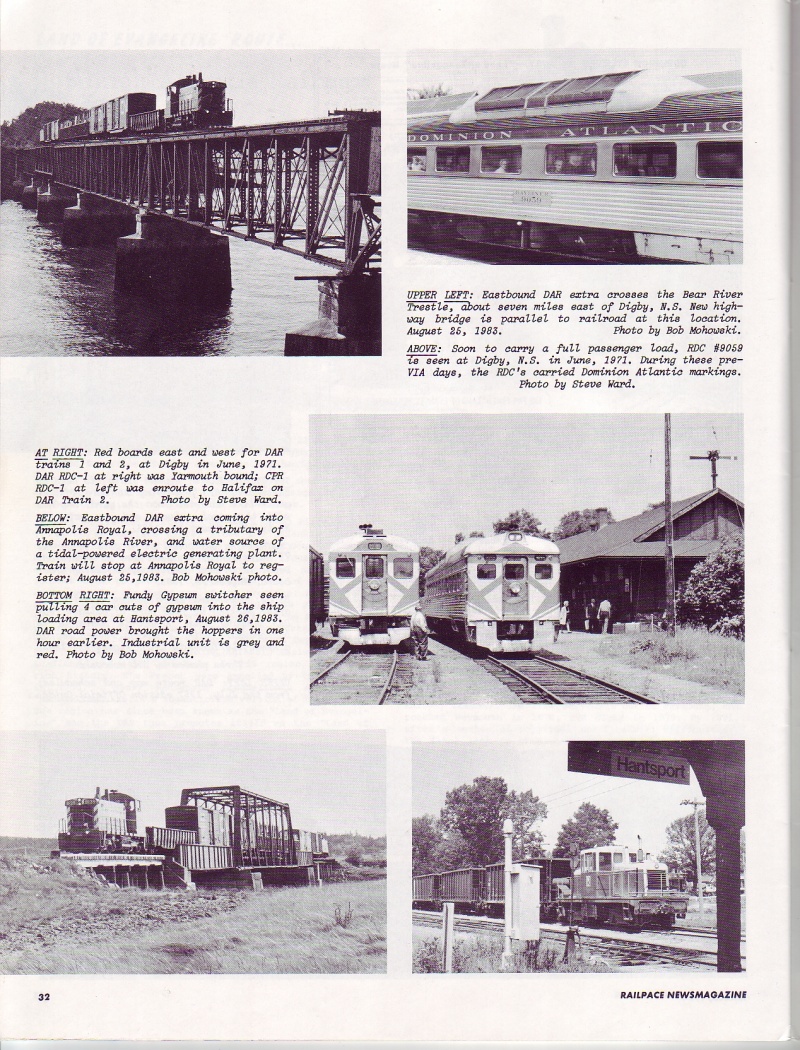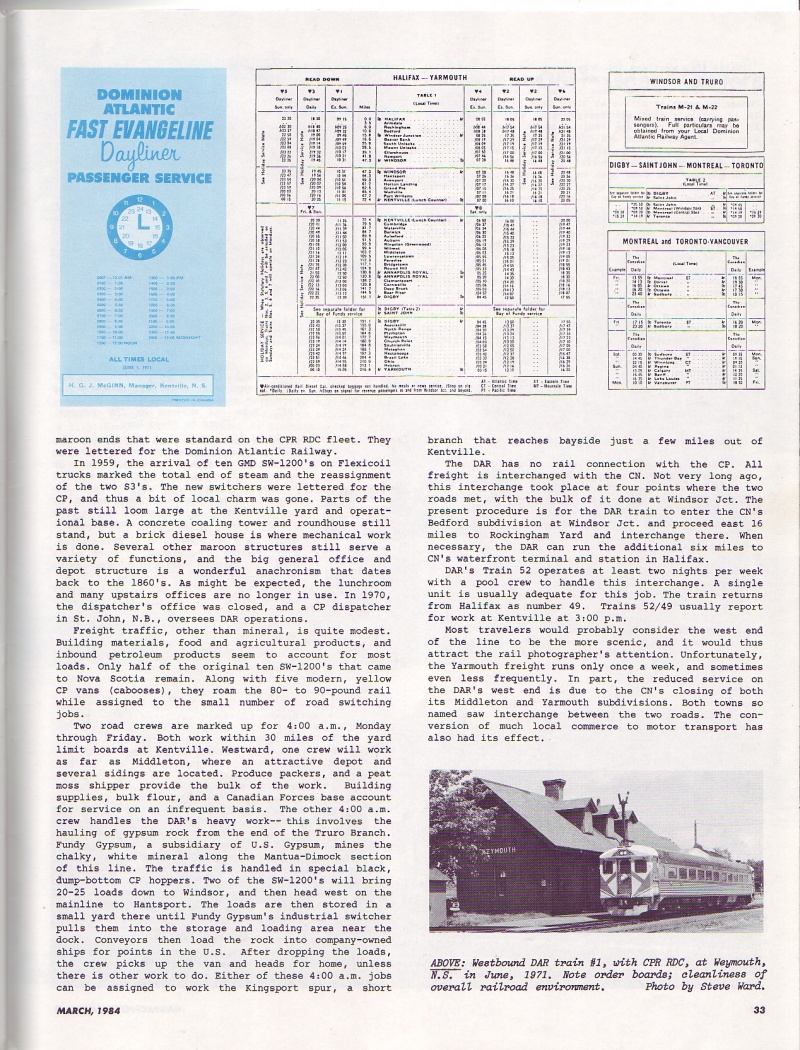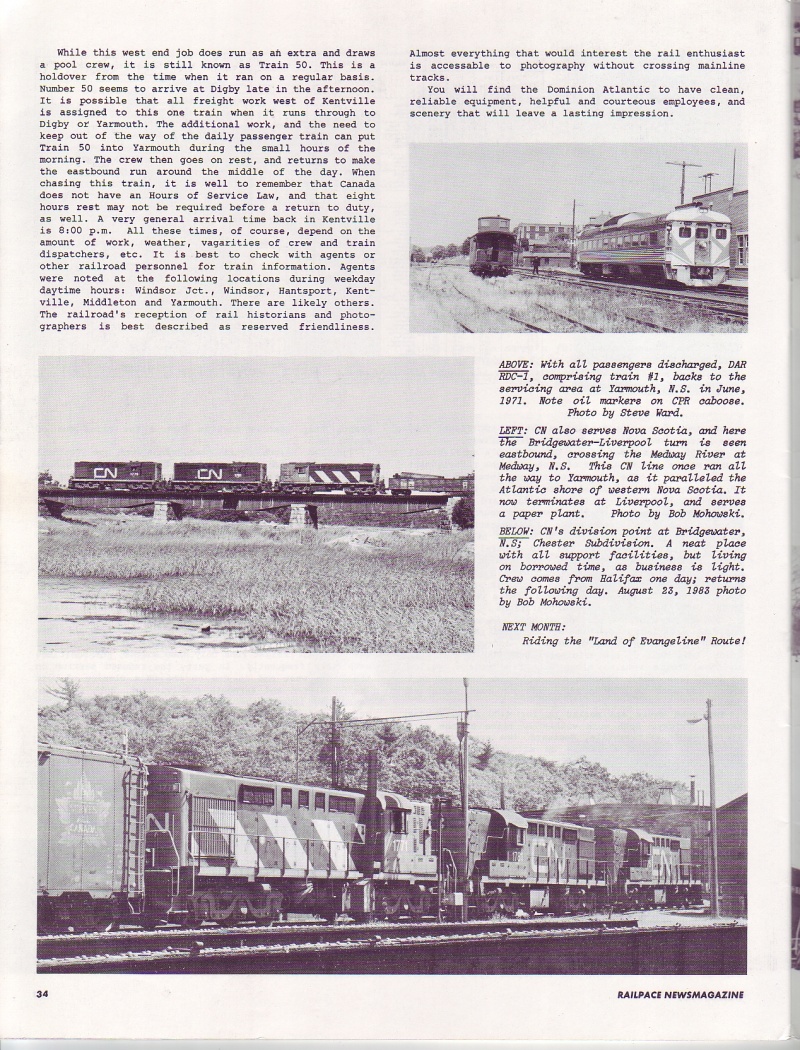Dominion Atlantic Railway Digital Preservation Initiative - Wiki
Use of this site is subject to our Terms & Conditions.
Railpace March 1984 - Land of Evangeline Route... D.A.R.
Railpace March 1984 - Land of Evangeline Route... Dominion Atlantic Railway
For search purposes a transcription of the text of this article (not including picture captions) follows below the illustrations.
CP's corporate image has not totally absorbed the "Land of Evangeline Route". Operations, geography, and some maroon paint preserve a distinct heritage.
Nova Scotia calls itself "Canada's Ocean Playground". It is an appropriate title, since the Atlantic touches upon its borders for all but a 20-mile boundary with New Brunswick and the Canadian mainland. Tourism, agriculture, fishing, and the development of natural resources seem to provide the main sources of income and employment for the residents of the province. In addition to the Dominion Atlantic, rail service is provided by the CN, VIA RAIL, and industry-owned lines on the eastern peninsula. It is the north coast of the western part of Nova Scotia; that which borders the famed Bay of Fundy, that is served by the Dominion Atlantic Railway. French Acadians, the early settlers of this region, left it a rich history. The French were expelled by the English in 1755. Henry Wadsworth Longfellow's epic poem, "Evangeline", tells a romanticized version of this event. The region has since been known as the "Land of Evangeline" and the DAR thus promotes itself as the "Land of Evangeline Route".
While its equipment is no longer lettered for the DAR, this easternmost CP Rail operation still clings to the old promotional line to some degree. The imposing general office building in Kentville still proudly bears a letter board proclaiming the Dominion Atlantic Railway. One can sense that in spite of CP and VIA lettering being predominate on the property, the DAR is not lost in the homogeneity of CP Rail. Fortunately, a well-patronized passenger service in the form of VIA RDC cars is available along the entire 200 miles of mainline, and keeps the road well within the public consciousness.
It's a "down home" type of train that touches villages and towns such as Brazil Lake, Weymouth, Meteghen, Digby, Annapolis Royal and Mt. Uniacke. Small engines equipped with road trucks and white extra flags spot cars for local grocery distributors, seafood processors and timber cutters. Kerosene markers glow on cabooses and a few manual-block semaphore blades stand out against a clear sky. Join us on a Summer, 1983 survey of a quaint Canadian operation...
HISTORY AND MOTIVE POWER
The first part of what was to become the Dominion Atlantic Railway was opened for traffic in 1858, and was called the Windsor Branch Railway. Apparently, this was built as a feeder for what is now the CN's transcontinental mainline. The two meet at Windsor Junction. The Nova Scotia government is believed to have pushed and possibly funded this first construction. It then passed an Act for the establishment of a rail line from Windsor to Annapolis Royal in 1865. The section between Windsor and Kentville was opened in 1869. Some changes must have taken place because this part of the route was then known as the Windsor & Annapolis. Later it was incorporated with the Yarmouth and Annapolis, to finally become the Dominion Atlantic Railway Company in 1895.
Surveys were undertaken to build a line between Annapolis Royal and Yarmouth as early as 1869. Construction began in 1873 under the name of the Western Counties Railway Company. The line was built out of Yarmouth, and reached Weymouth in 1876, and Digby in 1879. By 1891, after a series of political and financial difficulties, the final link to connect Digby and Annapolis was finished, and the DAR's mainline was complete.
The Truro Branch began life as the Midland Railway Company. It was completed in 1901, and acquired by the DAR in 1905. Service has only recently been suspended on most of this line. All holdings of the Dominion Atlantic Railway Co. were leased to the Canadian Pacific Ry. for 999 years from January, 1912. The line from Windsor to Windsor Jct. was leased from the government of Canada for 99 years from January, 1914.
Present-day employees still vividly recall the handsome G-2 Pacifics, and husky D-10 4-6-0's that worked across the DAR's profile in both passenger and freight service. Steam and diesel worked side by side for a brief while when a pair of MLW S3's arrived in 1956. They were the only diesels lettered for the DAR and perhaps carried the railway's crest emblem, as did the steam locomotive tenders. Along with the $3's, two Budd RDC-1's arrived in the same year, and were numbered 9058 and 9059. These carried the standard maroon letterboards and cream-and-maroon ends that were standard on the CPR RDC fleet. They were lettered for the Dominion Atlantic Railway.
In 1959, the arrival of ten GMD SW-1200's on Flexicoil trucks marked the total end of steam and the reassignment of the two 3's. The new switchers were lettered for the CP, and thus a bit of local charm was gone. Parts of the past still loom large at the Kentville yard and operational base. A concrete coaling tower and roundhouse still stand, but a brick diesel house is where mechanical work is done. Several other maroon structures still serve a variety of functions, and the big general office and depot structure is a wonderful anachronism that dates back to the 1860's. As might be expected, the lunchroom and many upstairs offices are no longer in use. In 1970, the dispatcher's office was closed, and a CP dispatcher in St. John, N.B., oversees DAR operations.
Freight traffic, other than mineral, is quite modest. Building materials, food and agricultural products, and inbound petroleum products seem to account for most loads. Only half of the original ten SW-1200's that came to Nova Scotia remain. Along with five modern, yellow CP vans (cabooses), they roam the 80- to 90-pound rail while assigned to the small number of road switching jobs.
Two road crews are marked up for 4:00 a.m., Monday through Friday. Both work within 30 miles of the yard limit boards at Kentville. Westward, one crew will work as far as Middleton, where an attractive depot and several sidings are located. Produce packers, and a peat moss shipper provide the bulk of the work. Building supplies, bulk flour, and a Canadian Forces base account for service on an infrequent basis. The other 4:00 a.m. crew handles the DAR's heavy work-- this involves the hauling of gypsum rock from the end of the Truro Branch. Fundy Gypsum, a subsidiary of U.S. Gypsum, mines the chalky, white mineral along the Mantua-Dimock section of this line. The traffic is handled in special black, dump-bottom CP hoppers. Two of the SW-1200's will bring 20-25 loads down to Windsor, and then head west on the mainline to Hantsport. The loads are then stored in a small yard there until Fundy Gypsum's industrial switcher pulls them into the storage and loading area near the dock. Conveyors then load the rock into company-owned ships for points in the U.S. After dropping the loads, the crew picks up the van and heads for home, unless there is other work to do. Either of these 4:00 a.m. jobs can be assigned to work the Kingsport spur, a short branch that reaches bayside just a few miles out of Kentville.
The DAR has no rail connection with the CP. All freight is interchanged with the CN. Not very long ago, this interchange took place at four points where the two roads met, with the bulk of it done at Windsor Jct. The present procedure is for the DAR train to enter the CN's Bedford subdivision at Windsor Jct. and proceed east 16 miles to Rockingham Yard and interchange there. When necessary, the DAR can run the additional six miles to CN's waterfront terminal and station in Halifax.
DAR's Train 52 operates at least two nights per week with a pool crew to handle this interchange. A single unit is usually adequate for this job. The train returns from Halifax as number 49, Trains 52/49 usually report for work at Kentville at 3:00 p.m.
Most travelers would probably consider the west end of the line to be the more scenic, and it would thus attract the rail photographer's attention. Unfortunately, the Yarmouth freight runs only once a week, and sometimes even less frequently. In part, the reduced service on the DAR's west end is due to the CN's closing of both its Middleton and Yarmouth subdivisions. Both towns so named saw interchange between the two roads. The conversion of much local commerce to motor transport has also had its effect.
While this west end job does run as an extra and draws a pool crew, it is still known as Train 50. This is a holdover from the time when it ran on a regular basis. Number 50 seems to arrive at Digby late in the afternoon. It is possible that all freight work west of Kentville is assigned to this one train when it runs through to Digby or Yarmouth. The additional work, and the need to keep out of the way of the daily passenger train can put Train 50 into Yarmouth during the small hours of the morning. The crew then goes on rest, and returns to make the eastbound run around the middle of the day. When chasing this train, it is well to remember that Canada does not have an Hours of Service Law, and that eight hours rest may not be required before a return to duty, as well. A very general arrival time back in Kentville is 8:00 p.m. All these times, of course, depend on the amount of work, weather, vagarities of crew and train dispatchers, etc. It is best to check with agents or other railroad personnel for train information. Agents were noted at the following locations during weekday daytime hours: Windsor Jct., Windsor, Hantsport, Kentville, Middleton and Yarmouth. There are likely others. The railroad's reception of rail historians and photographers is best described as reserved friendliness. Almost everything that would interest the rail enthusiast is accessable to photography without crossing mainline tracks.
You will find the Dominion Atlantic to have clean, reliable equipment, helpful and courteous employees, and
scenery that will leave a lasting impression.
